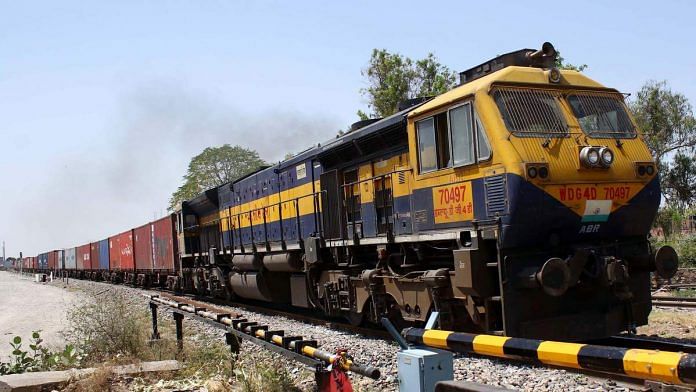New Delhi: An analysis of the Indian Railways’ goal of net-zero emissions by 2030 has found that it could lead to an annual reduction of “at least 15 million tonnes of CO2,” and save Rs 17,000 crore in fuel costs. This in turn could help India meet 5 per cent of its Paris Agreement commitment, a new report has said.
The report, released Wednesday, further added that solar energy could supply between 18 to 28 per cent of the Indian Railways’ needs, depending on traction load.
The report was prepared by Indian NGO Climate Trends and Riding Sunbeams, a UK-based organisation committed to decarbonising railways.
As part of the Paris Climate Accord, India pledged to generate 40 per cent of its power through renewable energy, create a carbon sink capable of absorbing 2.5 billion-3 billion tonnes of carbon dioxide, and made a commitment to reduce greenhouse gas emissions by 33 to 35 per cent of its intensity of GDP below 2005 levels.
The Indian Railways is the largest electricity consumer and third-largest diesel consumer in the country, and responsible for 4 per cent of India’s total greenhouse gas emissions.
“Official estimates show that, if India deploys 100 GW of solar power, IR could help meet 5% of India’s NDC target,” the report said.
Also read: The Paris Agreement will help fight climate change. But it’s missing a critical element
Net-zero emissions
The Indian Railways plans to fully electrify its tracks by 2023, and last year committed to net-zero emissions by 2030. Electric trains are considered less polluting than trains that run on diesel since they do not directly emit carbon dioxide.
Converting current diesel tracks to electric will result in a 32 per cent spike of CO2 emissions “due to India’s reliance on coal,” the report said, adding that this is predicted to fall as more and more coal plants are decommissioned in the future.
However, to mitigate this spike, the railways “will need either to procure its own supply of clean electricity from solar and wind generators connected directly into the rail network, or develop grid-connected renewable projects to decarbonise the traction energy supplied via the electricity grid.”
Over time, the Indian Railways’ shift to electrification will “speed up” the power sector’s decarbonisation.
“Becoming 100% electric means shifting emissions to the power sector, which is 76% powered by coal as of December 2020. The net-zero target means IR will be pushing the power sector to provide renewable energy instead of coal-based electricity,” the report said.
Shift to solar energy sources
The report also said that should the railways shift to solar energy sources, 6.8 million tonnes of carbon dioxide annually will be eliminated, contributing “substantially to the overall reductions” of 15 million tonnes from electrification.
The Indian Railways plans to install 20 gigawatts (GW) of solar for both traction loads (trains) and non traction loads (offices, railway stations etc).
“Right now India is leading the world on two vital climate frontiers – rail electrification and solar power deployment. Our analysis shows that connecting these two keystone low-carbon technologies together in Indian Railways can drive both India’s economic recovery from the Covid pandemic and its efforts to transition off fossil fuels to tackle the climate crisis,” Leo Murray, founder and director of innovation at Riding Sunbeams, said in a statement.
Also read: India’s no-show at London climate meet isn’t good news for UN’s COP26 talks






